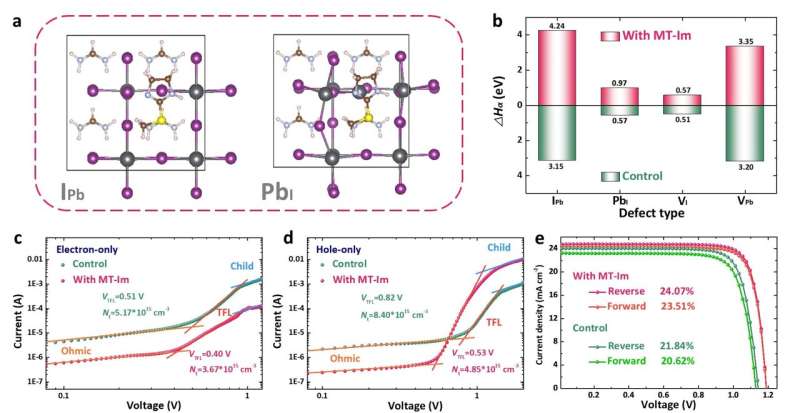a. Theoretical calculation model; b. the formation energy (△Hα) of interface defects; c,d. Defect density calculation and photovoltaic performance test of perovskite solar cells. Credit: Liu Guozhen.
Organic-inorganic halide perovskite materials have excellent optical capture capacity and carrier conductivity. Perovskite solar cells, with amazing power conversion efficiency, show great application prospects. However, a large number of unfavorable defects, growing up after or during annealing process due to their ionic nature, would lead to sites of nonradiative recombination and accelerate degradation of device efficiency and stability.
A research team lead by Pan Xu from the Hefei Institutes of Physical Science (HFIPS) of the Chinese Academy of Sciences (CAS), cooperating with Zheng Haiying from Anhui University, have achieved high-efficiency perovskite solar cells by passivating interface defects using new-type low-dimensional perovskite. Related work has been published in ACS Energy Letters.
The researchers passivated and stabilized the perovskite light absorbing layer with amphoteric heterocyclic cation, and designed a new-type low-dimensional perovskite passivation layer.
They found that the new perovskite, due to its amphoteric properties and strong molecular interaction, was able to deal with different surface-terminating ends and exhibited a variety of passivation effects.
According to the theoretical calculation of defect formation energy, the formation of lead-based defect was effectively inhibited. The modified perovskite solar cells displayed reduced defect density and lowered nonradiative recombination, thereby resulting in a power conversion efficiency of over 24%. In addition, the long-term stability against humidity, high temperature and light was improved.
More information: Guozhen Liu et al, Mixed-Phase Low-Dimensional Perovskite-Assisted Interfacial Lead Directional Management for Stable Perovskite Solar Cells with Efficiency over 24%, ACS Energy Letters (2021). DOI: 10.1021/acsenergylett.1c01878
Provided by Chinese Academy of Sciences
























